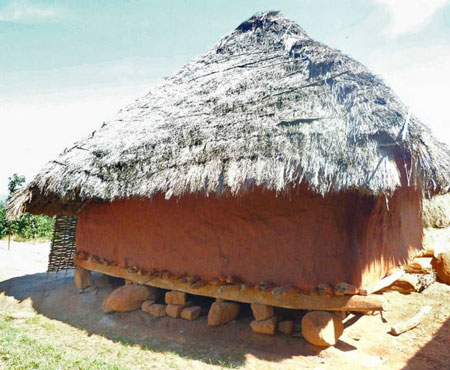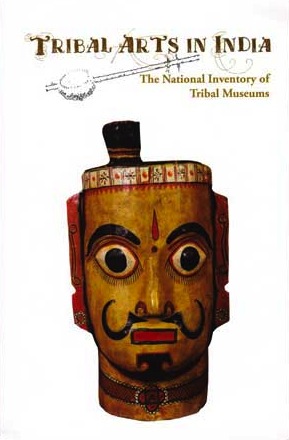
Photo © Serena Josephine M
On a gigantic rock at Pallakaniyur sits an example of Yelagiri’s own piece of traditional architecture, passed on for generations together. The dwelling of Govindasamy, with its unique structural design and construction techniques stands proof of the tribal culture of Yelagiri Hills.
Govindasamy, a coolie, does not know when his house was constructed. “This has been our home for several decades,” he added. The tribal hut follows a set pattern of construction and takes 60 days for completion, Ramasamy, a villager of Pallakaniyur noted.
A ‘thinna’, constructed on either side of the entrance welcomes visitors to this tribal hut. Inside the house is a huge container made of bamboo and soil, further reflecting the tribal culture. This container is used to store grains.
“We have certain methods to construct the hut. First, boulders and small-sized rocks are placed on the ground. Wooden logs are kept on these boulders. Then, we use iron rods to crush the red soil. This is soaked in water for some time and mixed by treading. The soil is made into balls and these are raised as walls,” he explained. […]
Lemon grass is used to form the roof of the hut.
A few villagers have constructed similar type of houses but with the foundation on the ground, unlike the traditional huts which use boulders and wooden logs.
To give the annual summer festival held last year a glimpse into the tribal aura of Yelagiri, the district administration had constructed a tribal hut by roping in the villagers near the first hairpin bend leading to the hill. This tribal hut had served as the reception centre for the festival.
“We were roped in to construct the tribal hut down the hill. Nevertheless, such huts are becoming rare in Yelagiri as many villagers now prefer concrete structures. But these tribal huts are much stronger,” he added. […]
Source: “Tribal architecture and culture, passed on through generations” by Serena Josephine M., The Hindu, 30 January 2013 – The Hindu
Address : https://www.thehindu.com/todays-paper/tp-national/tp-tamilnadu/tribal-architecture-and-culture-passed-on-through-generations/article4359679.ece
Date Visited: 27 January 2023
Are the ‘goods’ and ‘bads’ of physical events such as global warming equally distributed? Are there proper climate governance mechanisms sensitive to differentiated responsibility and risks, mitigated justly for suffering marginalised communities? | Read “Climate Justice: India Is Disproportionately Endangered – as Are Some Indians” on Mongabay | Learn more about climate change | United Nations on climate change >>
The demand for sand has crossed sustainable threshold limits, and mindless extraction to keep the supply going cannot continue. Growing environmental degradation caused by mining has buttressed the case for regulating supply. More important, the present crisis imposes a responsibility on the Indian construction industry, which has an annual turnover of about Rs. 384,000 crore, quickly to find substitutes and consider modes of recycling.
Sand is an ubiquitous raw material in construction. It is a cheap and an essential ingredient to create workable mortar and strong concrete. A sturdy floor requires a well laid-out and an even sand bed. Yet, sand is not difficult to replace in this sector; alternatives are available. […]
Source: “Looking at substitutes” by A. Srivathsan, The Hindu, 11 August 2013
Address : https://www.thehindu.com/news/national/looking-at-substitutes/article5010520.ece
Date Visited: 1 September 2020

Read or download titles for free (eBooks & Magazine) >>
Yelagiri will host the summer festival drawing inspiration from tribal aura of the hills. Arrangements are apace with plenty of cultural festivities, contests and events being lined up. The district administration has come up with a logo for the summer festival this year.
With the festival all set to be held on June 2 and 3, the administration is looking at exploring and showcasing local characteristics of the hill. […]
“We want to explore locally available materials. The logo itself carries a tribal hut. We want to display the tribal culture of Yelagiri. In fact, we are looking at the possibility of setting up a reception centre at Ponneri by putting up a tribal hut there. We are also thinking of bringing in food which is unique to Yelagiri in the food court planned for the festival,” Sub-Collector of Tirupattur Shilpa Prabhakar said. […]
Source: Summer fete at Yelagiri on June 2, 3
URL: https://www.thehindu.com/todays-paper/tp-national/tp-tamilnadu/summer-fete-at-yelagiri-on-june-2-3/article3461656.ece
Date visited: 8 January 2019
[Bold typeface added above for emphasis]
Indigenous people represent only about six percent of the world’s population, but they inhabit around a quarter of the world’s land surface. And they share these regions with a hugely disproportionate array of plant and animal life. According to the UN and the World Bank, about 80 percent of our planet’s biodiversity is on land where indigenous people live.
“There is a need to explore the tribal consciousness in the backdrop of climate change, development, and deforestation.” – Deepanwita Gita Niyogi in “India’s Adivasi Identity in Crisis” Pulitzer Center May 27, 2021 | Learn more about climate change and illegal mining | United Nations on climate change | Find free publications on India’s hunter-gatherers in the Unesco Digital Library >>

What is caused (and not caused) by climate change?
How data can help fight a growing tendency by politicians and journalists to overstate the role of climate change| Learn more or listen here >>
Up-to-date reports by Indian journalists and commentators
To search Indian periodicals, magazines, web portals and other sources safely, click here. To find an Indian PhD thesis on a particular tribal community, region and related issues, click here >>
Search tips
Combine the name of any particular state, language or region with that of any tribal (Adivasi) community.
Add keywords of special interest (music, poetry, dance just as health, sacred grove and biodiversity); learn about the rights of Scheduled Tribes such as the “Forest Rights Act” (FRA); and the United Nations “Declaration on the Rights of Indigenous Peoples”, “Universal Declaration of Human Rights”, “women’s rights”, or “children’s right to education”.
Specify any other issue or news item you want to learn more about (biodiversity, bonded labour and human trafficking, climate change, ecology, economic development, ethnobotany, ethnomedicine, global warming, hunter-gatherers in a particular region or state, prevention of rural poverty, water access).
For official figures include “scheduled tribe ST” along with a union state or region: e.g. “Chhattisgarh ST community”, “Himalayan tribe”, “Scheduled tribe Tamil Nadu census”, “ST Kerala census”, “Particularly Vulnerable Tribal Group Jharkhand”, “PVTG Rajasthan”, “Adivasi ST Kerala”, “Adibasi ST West Bengal” etc.
In case the Google Custom Search window is not displayed here try the following: (1) toggle between “Reader” and regular viewing; (2) in your browser’s Security settings select “Enable JavaScript” | More tips >>
Note: hyperlinks and quotes are meant for fact-checking and information purposes only | Disclaimer >>
See also
Adivasi Academy & Museum of Adivasi Voice at Tejgadh
Atree.org | Ashoka Trust for Research in Ecology & the Environment (posts)
Biodiversity | Hyderabad biodiversity pledge | Nilgiri Biosphere
eBook | Background guide for education
Tips for using interactive maps
Toggle to normal view (from reader view) should the interactive map not be displayed by your tablet, smartphone or pc browser
For details and hyperlinks click on the rectangular button (left on the map’s header)
Scroll and click on one of the markers for information of special interest
Explore India’s tribal cultural heritage with the help of another interactive map >>